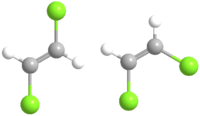- 1,2-dichloroéthène
-
1,2-dichloroéthène 


E-1,2-dichloroéthène (trans, à gauche) et Z-1,2-dichloroéthène (cis, à droite)Général Nom IUPAC 1,2-dichloroéthène Synonymes 1,2-dichloroéthylène
dichloracéthylène
dichlorure d'acétylène
1,2 dichlorure d'acétylène
1,2-DCENo CAS (mélange)
(Z ou cis)
(E ou trans)No EINECS (mélange)
(Z ou cis)
(E ou trans)No RTECS SMILES InChI Apparence liquide incolore mobile avec une odeur de chloroforme Propriétés chimiques Formule brute C2H2Cl2 [Isomères] Masse molaire[1] 96,943 ± 0,006 g·mol-1
C 24,78 %, H 2,08 %, Cl 73,14 %,Moment dipolaire Z (cis): 1.9 D
E (trans): 0 DPropriétés physiques T° fusion -81 °C (Z)
-50 °C (E)[2]T° ébullition 60 °C (Z)
48 °C (E)[2]Masse volumique 1,29 g·cm-3 (Z)
1,26 g·cm-3 (E)[2]T° d'auto-inflammation 460 °C Point d’éclair 2-4 °C Pression de vapeur saturante 24 kPa (Z); 35 kPa à 20 °C
33 kPa (Z); 54,7 kPa à 30 °C[2]Précautions Directive 67/548/EEC[2] 
Xn
FPhrases R : 11, 20, 52/53, Phrases S : 7, 16, 29, 61, Unités du SI & CNTP, sauf indication contraire. Le 1,2-dichloroéthène ou 1,2-dichloroéthylène ou 1,2-dichloroacétylène est un alcène chloré. C'est un puissant solvant très inflammable. Il ne doit pas être confondu avec le 1,2-dichlorure d'éthylène, nom ancien du 1,2-dichloroéthane.
Usages
C'est un intermédiaire de synthèse de solvants et de composés chlorés.
Il est surtout utilisé comme solvant de résines, graisses, parfums, colorants, laques, plastiques thermosensibles, phénols, etc, utilisé aussi pour extraire à froid des produits sensibles à la chaleur (caféine, caoutchouc, matières grasses parfumées, etc). Il est utilisé dans certains dégraissants de métaux.
Toxicité
Un de ses isomères[Lequel ?] est mutagène in vitro, mais les données toxicologiques disponibles ne laissent pas penser qu'il est cancérigène.
Notes et références
- Masse molaire calculée d’après Atomic weights of the elements 2007 sur www.chem.qmul.ac.uk.
- Fiche toxicologique INRS
Catégories :- Produit chimique nocif
- Produit chimique facilement inflammable
- Produit chimique dangereux pour l'environnement
- Solvant
- Chloroalcène
Wikimedia Foundation. 2010.
